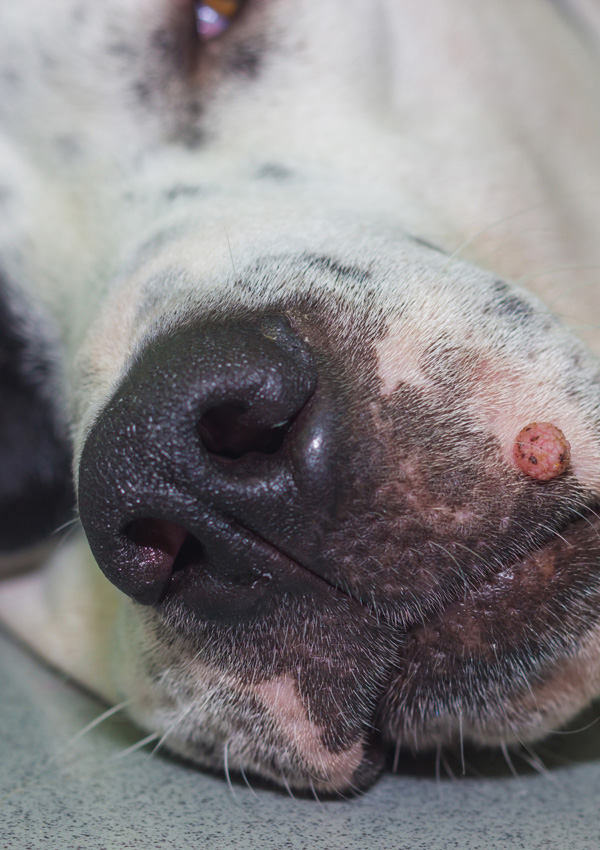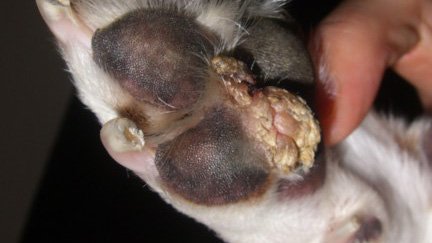Papillomas or simply warts do not adorn either people, no animals. And if your own papillomas are human notices almost immediately after they appear, then dog warts can remain unattended long enough, especially in cases when the animal is not shown to the veterinarian annually for prophylaxis. Not only do hated growths look completely unattractive, they also significantly interfere with doggies. And the most disgusting so that papillomas in dogs can degenerate into malignant tumors. In this article we try to figure out what are the causes of papillomas in animals, how can I catch the disease, and is it worth it to pick treatment at home without going to a specialist.
How a dog develops papillomatosis
Contents
If on the body (on the muzzle, trunk, extremities, in the eye area or in the mouth (including on the tongue and lip), on the genitals) there are rough growths affecting the mucous tissues and upper layers of the skin, then speech It’s about viral papillomatosis. In other words, this ailment is an infection that spreads from one dog to another, but on the human body, the virus, fortunately, does not infringe. Like a doggie can catch the virus? Very simple: during contact with the infected by an individual (sexual intercourse, food from one bowl, wearing a collar after an infected dog papilloma virus, etc.). First small warts can appear in a dog in about 3-5 weeks после проникновения зловредного вируса в организм. В зависимости от места возникновения вирусныйpapillomatosis in dogs is divided into the following types:
В зависимости от места возникновения вирусныйpapillomatosis in dogs is divided into the following types:
- Genital – from the name it is clear that neoplasms appear on the penis or on the mucous surface of the vagina;
- Oral – with a similar kind of papillomatosis medium-sized wrinkled growths are initially formed only in the mouth, but then they can occur in the nose of the dog, on the eye;
- Cutaneous – with this type of neoplasm papillomatosis relatively smooth and small, located on the head (on the ears, on the eyelid) and on the limbs;
- Transitional – papillomas in this form diseases are located on the skin in the armpits and on the stomach.
It’s impossible to say that papillomatosis is the worst of the viral diseases. However, sensitive warts, inside of which there are many small vessels, can be easily injured, which is fraught with bleeding and blood poisoning. Besides Moreover, such an ailment, although rare, can threaten oncology. Here why you should not leave papillomas unattended.
Which pet is at risk?
Theoretically, any dog can catch the virus. However veterinarians note that more often than others suffer from viral papillomatosis:
- Dogs of the pug, cocker spaniel, mittel, rizen and miniature schnauzers, representatives of a group of terriers;
- Young puppies aged 3-6 months;
- Adult dogs with weak immunity;
- Elderly animals.
It would seem that detecting a neoplasm on the dog’s body does not amount to labor for the owner. However, not all so simple. If papilloma in dogs on the eye, it’s easy to see. And if she lurks in the armpit doggie with a luxurious fur coat? Then notice the “uninvited guest” is not so simple. However, almost no papilloma will remain unnoticed during a veterinary examination by a doctor who will give attention and the dog’s mouth, and ears, and genitals, and interdigital space. However, some specific symptoms papillomatosis still has, and they can be noticeable to the owner:
- If neoplasms in the mouth, the dog may have problems with eating food. Strong salivation and unpleasant odor from mouth, decreased appetite;
- When a dog has papilloma on its paw, a cautious limping gait;

- The papillomas themselves do not hurt the dog, but may well bleed if a doggie hooks them with teeth or claws;
- With nasal papillomas, the animal may have difficulty with breathing. Clear mucus will flow from the nostrils;
- Papillomas in the eye are fraught with lacrimation and squinting;
- A small tubercle-papilloma grows rapidly, becoming all more noticeable. Often, the growth also itches, which leads to constant combing.
How to treat dog papillomas
Papillomas have, perhaps, one positive quality: in some cases, they disappear by themselves about a month or two after occurrences. But this does not always happen. Sometimes on the body of the animal growths appear one after another, like mushrooms after a rain. And this firstly, ugly, and secondly, dangerous, at least the same trauma. What treatment is most often used at home conditions?
- Celandine juice – an effective but dangerous toxicity its means. Celandine oral papillomas are definitely not treated follows;
- Garlic juice – this substance is also dangerous for the dog. (vomiting, diarrhea, heart rhythm disturbances, etc. may appear). If a doggie licks at least 1-2 ml of garlic juice, then there may be unpleasant consequences;
- Bandaging papillomas with a thread – firstly, not every the dog agrees to patiently wait for the owner to “conjure” over bandaging the neoplasm with a nodule. Secondly, in this way you can easily bring an infection into the body of an animal;
- Cauterization with acetic acid – from such a liquid papillomas may dry out, but it’s better not to use it because the possibility of burns to the skin or mucous membranes.
Among folk methods for removing papilloma in a dog, they call it the use of juice of potatoes, beets, onions, horseradish, dandelion, mountain ash, aloe, wormwood. However, it is better not to test on a pet ancient treatment, and entrust papilloma removal specialist.A veterinarian after a biopsy of the growth will suggest the following healing methods: surgical or cryological removal, laser therapy, cauterization by thermocauter, application antibiotics (“Azithromycin”), immunomodulators (“Interferon”), antiviral sera.






